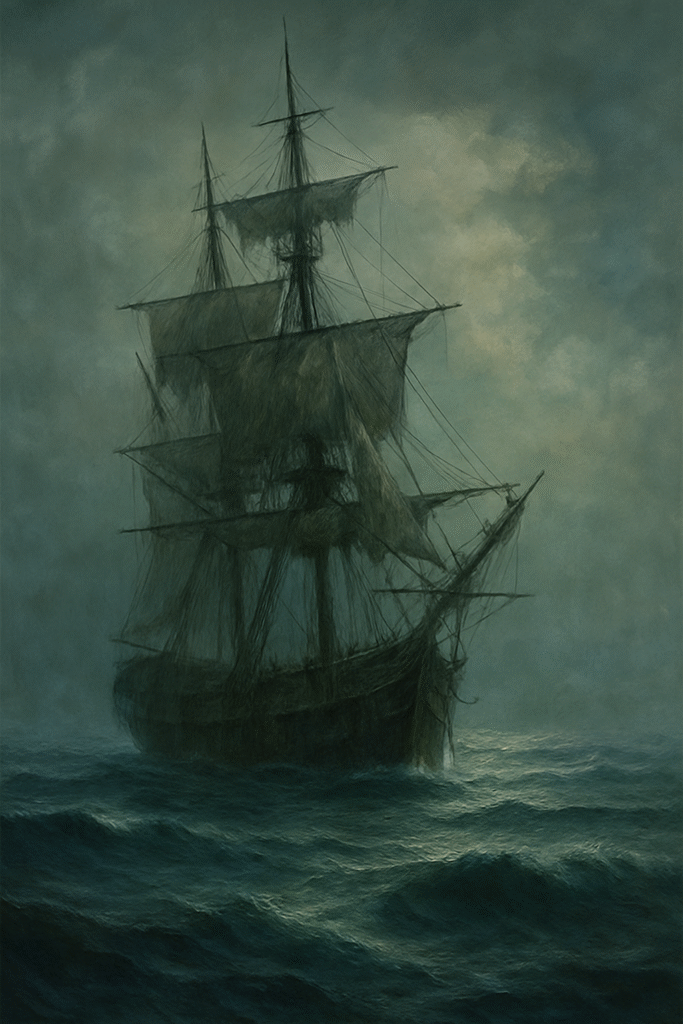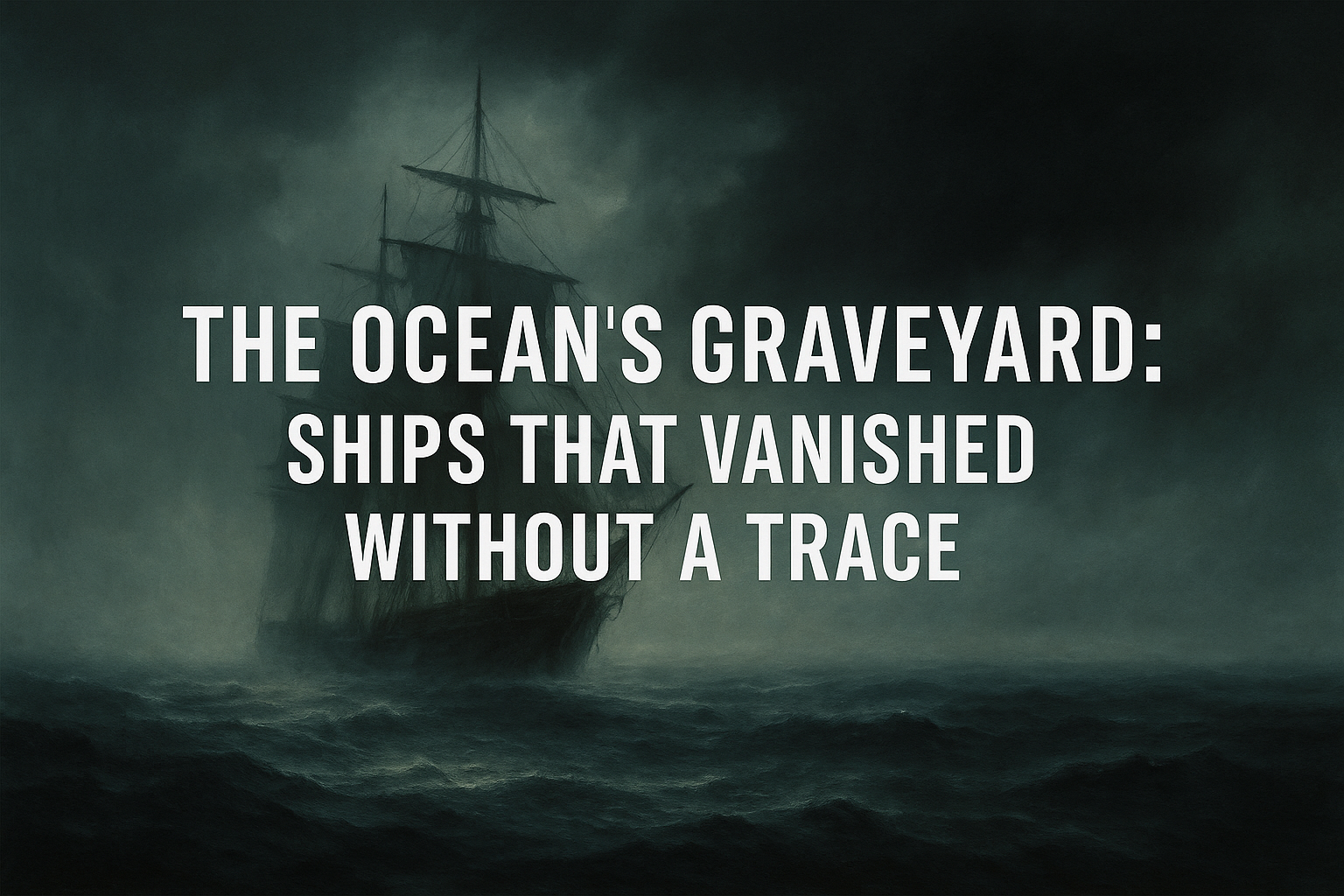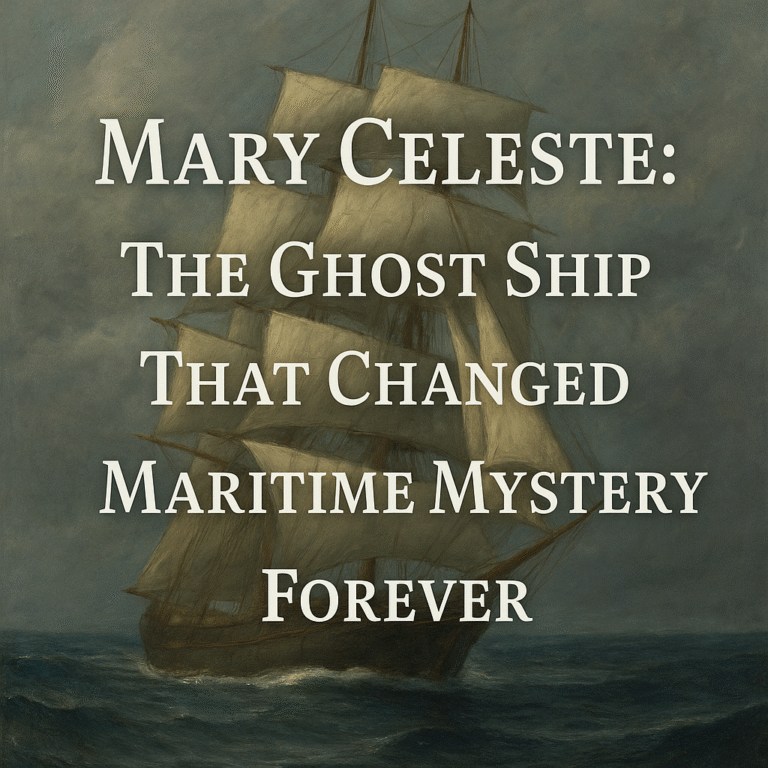
🌊 Introduction – Why the Sea Still Swallows Ships
Satellites blanket the globe, shipping lanes are jam-packed with AIS transponders, and radar can spot a dinghy in a storm. Yet the ocean—the last great wilderness—still steals vessels without leaving a splinter behind.
These disappearances fascinate because they combine unsolved mystery, human drama, and the raw power of nature. In this 1 500-plus-word deep dive, we chart nine famous cases where ships vanished—or were found eerily deserted—earning the Atlantic, Pacific, and Indian Oceans the chilling nickname “the ocean’s graveyard.”
1. Mary Celeste (1872) – The Classic Ghost Ship
Discovered drifting near the Azores, the Mary Celeste was perfectly seaworthy but totally crew-less. Cargo intact, meals half-eaten, lifeboat missing. No final log entry explains why Captain Briggs, his family, and crew abandoned ship.
Leading theories:
- Alcohol fumes from the 1 701 barrels of industrial spirits caused panic.
- A waterspout flooded the hold, tricking the crew into thinking she would sink.
- Piracy or insurance fraud—though no signs of struggle were found.
Whatever happened, the Mary Celeste remains the benchmark for maritime mystery.
2. USS Cyclops (1918) – Largest U.S. Naval Loss Outside War
With 306 crew and passengers, the 542-foot collier USS Cyclops left Barbados for Baltimore and vanished in calm seas. The “Marine Railroad” never sent a distress signal.
Suspicions:
- Structural failure—she sailed heavily overloaded with manganese ore.
- Enemy action—U-boat attack (unlikely; German records show none in area).
- Mutiny or sabotage by the German-born executive officer.
Despite modern sonar searches, no wreckage has ever been confirmed.
3. SS Waratah (1909) – “Titanic of the South”
Australia-bound, the 500-passenger liner Waratah disappeared along South Africa’s Wild Coast. Last radioed ship described heavy following seas before all contact ceased.
Searches in 1921, 1991, 1999, and 2004 failed to locate remains. Oceanographers blame rogue waves and treacherous Agulhas Current; some descendants still fund expeditions, hoping technology will finally reveal her grave.
4. MV Joyita (1955) – Found Adrift with No Crew
A 70-foot trading yacht left Samoa with 25 aboard. Five weeks later Joyita was found partially submerged 600 mi away, radio tuned to distress frequency, logbook missing, but supplies untouched.
Investigators noted a damaged cooling pipe and pump failure, yet the vessel was unsinkable due to cork-lined holds.
Speculations:
- Crew took lifeboats after flooding—but why abandon a more buoyant ship?
- Mutiny or piracy—though valuables remained.
Joyita’s fate illustrates how confusion and fear can doom even a salvageable ship.
5. HMS Erebus & HMS Terror (1845) – Franklin’s Polar Enigma
Sir John Franklin’s Arctic expedition sought the Northwest Passage. Both reinforced steamships became icebound. All 129 men died, but no one knows the exact chain of events.
Beached lifeboats containing silverware suggest desperation. Inuit testimony spoke of starving white men and possible cannibalism.
Only in 2014 and 2016 did Parks Canada locate the wrecks—largely intact—under silt and sea ice, reminding us how effectively the polar ocean hides secrets.
6. SS Ourang Medan (1947?)* – Dead Men’s Morse
Radio operators allegedly heard a chilling SOS:
“All officers including captain dead… I die.”
When rescuers boarded, they found the Indonesian freighter’s crew frozen in horror, eyes wide, arms outstretched—then the ship exploded and sank.
No registration records match “Ourang Medan,” leaving many historians to label it legend. Yet its tale keeps resurfacing in maritime folklore as a warning about unexplained forces at sea.
7. Flight 19 & PBM-5 Mariner (1945) – Air Mystery Meets Sea Mystery
Five U.S. Navy Avenger bombers on a routine exercise over the Atlantic radioed instrument failure before disappearing near the Bahamas. The massive PBM-5 search plane sent after them also vanished with 13 crew.
Wrecks remain undiscovered, fueling Bermuda Triangle lore. Although storms, magnetic anomalies, and fuel exhaustion are plausible, the complete absence of debris still puzzles researchers.
8. MV Derbyshire (1980) – Largest British Ship Ever Lost at Sea
The 294-m ore-oil carrier disappeared south of Japan during Typhoon Orchid. All 44 crew and dependents lost. For 14 years no wreckage turned up—until 1994, when side-scan sonar found her in two pieces 4 km down.
Investigators concluded bow hatch failure led to catastrophic flooding—proof that engineering oversights can sink even modern giants and vanish them in minutes.
9. SS Carl D. Bradley (1958) – Deadly Freshwater “Bermuda Triangle”
Great Lakes earn their own reputation: the 639-ft Bradley snapped in a freak November gale on Lake Michigan. Despite distress calls, only two survived; most bodies were never recovered.
Sonar located the split wreck in 330 ft of water, but many Midwesterners still speak of a Great Lakes “triangle” swallowing ships in sudden squalls.
🌪️ Why Ships Disappear: Five Key Factors
| Factor | How It Erases Evidence |
|---|---|
| Severe Weather / Rogue Waves | Can break hulls instantly; wreckage sinks in minutes |
| Structural or Design Flaws | Hatch failures, overloaded holds accelerate flooding |
| Navigation & Human Error | Miscalculated storms, wrong headings, radio silence |
| Geological Forces | Subduction trenches, deep polar basins hide wrecks beyond current ROV range |
| Piracy / Sabotage | Crews abducted, ships scuttled or repurposed under new names |
Even with GPS and ELTs, the combination of furious seas, vast depths, and rapid sinking can leave no floating debris—turning modern vessels into instant legends.
🛰️ Modern Search Tech: Closing the Ocean’s Graveyard?
- Side-scan sonar & AUV mapping have found Derbyshire, Erebus, and lost WWII subs.
- Satellite synthetic-aperture radar can spot oil slicks where hulls fracture.
- AI-driven drift modeling traces flotsam back to probable sinking zones (used in MH370 search).
Yet 80 % of the seafloor is still unmapped in high resolution. The ocean keeps its deepest graves well hidden.
🌊 Lessons from Lost Ships
- Engineering evolves through tragedy – Derbyshire led to stronger bulkhead standards.
- Myths endure without closure – Mary Celeste and Ourang Medan fuel maritime lore.
- Nature remains humbling – Even steel leviathans can vanish like wooden schooners.
- Search tech needs funding – Remote-ocean disappearances (e.g., Cyclops) show limitations in global search response.
Every vanished vessel is a cautionary tale for sailors—and a haunting reminder that the sea always has the last word.
Check out books about Ocean Graveyard On Amazon.
Visit TimePinned for more blogs.








